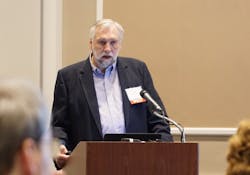Putting the problem in perspective, he noted that people in IT have generally had to go through multiple skills upgrades over the past 30-40 years. By contrast, he said, someone trained to program and operate a Programmable Logic Controller (PLC) can get by with essentially the same skills required for the first generation of products.
Greg Gorbach at IIC Forum in Cambridge, MA
Other differences include cycle times (IT updates and alters systems frequently, OT, rarely) and focus. For IT departments, business transformation and new technology is a never-ending quest. For OT, “information tech is almost a distraction, their focus is on producing things,” says Gorbach.
Gorbach said, moving toward the future, there are four general options for bridging the gap between IT and OT:
1) Provide manufacturing with its own IT group and budget
2) Put some IT folks into manufacturing and automation functions
3) Put all automation and engineering functions within IT
4) Continue with separate domains and systems and “just throw things over to the other side”
Gorbach says most companies are following the fourth path, though some have had success with the third option. One and two remain mostly untried. Regardless, though, he says it is imperative for companies to begin to quickly find ways to unite IT and OT. Why? According to Gorbach, the capabilities of analytic tools are growing rapidly and digital transformation is rewriting the rules of industry – destroying slow adapters such as Blockbuster, Borders, and Kodak. “When ARC looks at IIoT we take a broad view – we focus on IIoT as transformative for industry, with automation enabled through expanded use of sensors” and digital information as a transformative force, too.
A more positive way of framing the argument, according to Gorbach, is through the Law of Accelerating Returns, a concept developed by tech pioneer Ray Kurzweil to explain the present and hint at the future. According to Kurzweil’s formulation, “An analysis of the history of technology shows that technological change is exponential, contrary to the common-sense 'intuitive linear' view.”
Gorbach says that, in the age of the IIoT, industry is poised for exponential change because all the ingredients are available – but IT-OT integration is a necessary step, and one that will pay dividends. The results, he says, will “increase the value of existing infrastructure, provide both new opportunities and risks for manufacturing, and allow reinvention of the relationship with the customers.”
“It’s not if, but when – so you need a strategy to deal with this disruption,” he adds.
Alan R. Earls is a Boston-based writer focused on technology, business, and manufacturing — a field where he spent the earliest part of his career. He has written for publications and websites as diverse as The Boston Globe, Computerworld and Modern Infrastructure as well as Industry, The Manufacturer, and Today's Machining World and is a regular contributor to the Smart Industry Connect blog.






